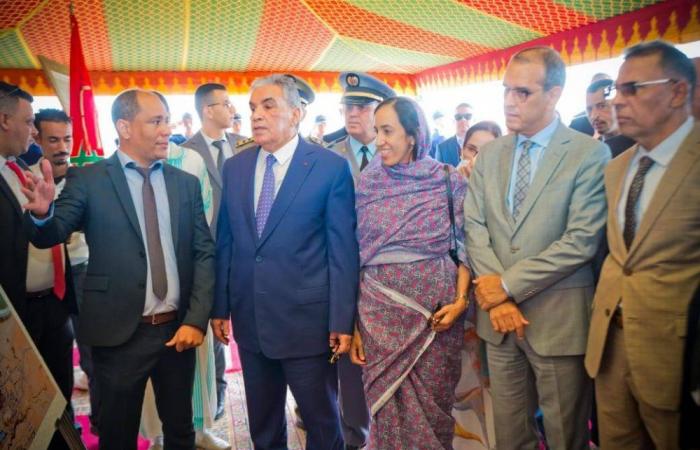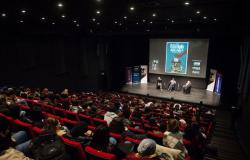The celebrations of the 49th anniversary of the Green March in the southern provinces took on, this year, a particularly symbolic dimension to So-So. As the first rays of sunlight caressed the waters of the Atlantic on the morning of November 4, an unusual excitement reigned in the port. In this coastal town of Moroccan Saharaprecisely in the commune of El Ouatia, the wali of the Guelmim-Oued Noun region, Mohamed Najem Abhaythe president of the region, Mbarka Bouaïdathe new governor of Tan-Tan, Abdellah Chatr, and numerous elected officials and other representatives of local and regional authorities have kicked off projects that are as ambitious as they are structuring for the region. Projects which, beyond their technical dimension, embody the continuity of the spirit of the Green March: transforming the desert into a land of development and prosperity, the most important project being the modernization of the port of Tan-Tan.
The symbolism of a launch
It is under the sign of historical continuity that the port of Tan-Tan begins its molt. The choice of the festivities of November 6, the anniversary of the Green March, to launch this vast modernization project is not insignificant. Forty-nine years after this historic event which marked the recovery of the southern provinces, Morocco continues its commitment to the development of these territories. The presence of Mbarka Bouaïda, president of the Guelmim-Oued Noun region, alongside Wali Mohamed Najem Abhay and Governor Abdallah Chater, testifies to the strategic importance given to this project.
A strategic port in full transformation
Built in 1977 and operational since 1982, the port of Tan-Tan has established itself as a pillar of the regional economy. Located 25 kilometers south of the eponymous city and 350 kilometers from Agadir, this port infrastructure of 78.5 hectares, including 27 hectares of basin, occupies a privileged geographical position (28°30 North and 11°21 West). Its central position on the Tangier-Lagouira axis makes it a nerve point for the economic development of the Kingdom.
A multi-faceted modernization
The modernization program launched on Monday November 4 is divided into several complementary components which aim to fundamentally transform the port’s capacities:
• The hydraulic revolution: At the heart of the project is the brackish water demineralization station, an investment of 47.7 million dirhams. Operating by reverse osmosis, this installation will produce 17 liters of water per second and will have a 200 cubic meter tank. The establishment of this station responds to clearly defined strategic objectives. First challenge: achieving self-sufficiency in drinking water within the port, a crucial necessity for an infrastructure of this scale. The project also aims to meet a growing demand for water, thus anticipating future needs linked to the development of port activities. Improving operating conditions constitutes another major axis, as is strengthening ice production activities, essential to supporting the maritime fishing sector, the real economic lifeblood of the region. This station, whose construction will take place over 12 months, fits perfectly into the vision of a modern, autonomous and environmentally friendly port.
• Infrastructure and sustainable development: the modernization also includes the rehabilitation of the sanitation network (17 million dirhams), including more than 5,310 meters of pipes and two pumping stations. The electrical aspect is not left out with an upgrade of the low and medium voltage networks (5 million dirhams). A solar power plant, budgeted at 11.5 million dirhams, will complete this system, embodying the project’s environmental commitment.
• Modernization of port infrastructure: The work also includes the rehabilitation of medians and fish unloading docks (24.5 million dirhams), as well as the restoration of roads in two phases (32 million dirhams in total). These improvements aim to optimize operating conditions and support the maritime fishing sector.
A regional partnership model
The particularity of this project lies in its equal financing method:National Ports Agency (ANP) and the region of Guelmim-Oued Noun each contribute 50% of the total budget. This collaboration illustrates a new approach to territorial development, where regions are directly involved in major structuring projects.
Expected socio-economic impact
The project is part of a broader vision of regional development. For the province’s elected officials, this modernization should encourage the creation of indirect jobs in various sectors: catering, hotels and specialized services linked to port activities. The province of Tan-Tan, which has 86,134 inhabitants spread over 17,300 km², sees this project as an opportunity to diversify its economy, historically dominated by fishing.
Future outlook
By 2027, the port of Tan-Tan aims to become a model of sustainable port development. This modernization is part of the national port strategy for 2030, which notably provides for the possibility of establishing a regional shipyard. The port thus positions itself as a catalyst for regional development, combining economic performance and environmental responsibility. The modernization of the Tan-Tan port represents more than just an infrastructure project. It is a symbol of the continuity of Morocco’s commitment to its southern provinces, a promise of economic development and a model of ecological transition. By celebrating the 49th anniversary of the Green March with the launch of this project, the Kingdom is reaffirming its vision of inclusive and sustainable territorial development.






